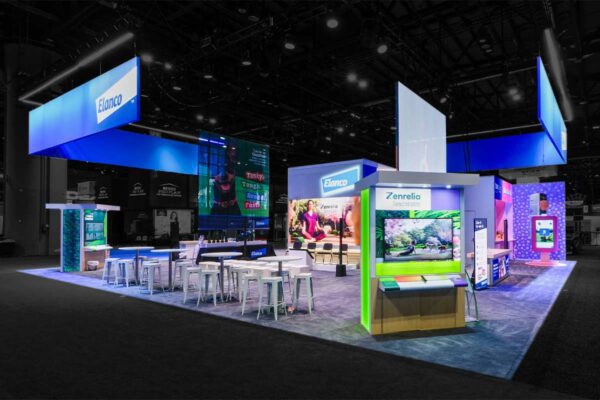Over the last two years, the trucking industry has “potentially endured the most severe drop in freight volume ever.” As a result, trucking industry freight levels and revenues are not expected to return to pre-recession levels until sometime in 2011.

“2009 was a terrible year for trucking overall, the worst year in decades,” said Bob Costello, chief economist for the American Trucking Association (ATA). “Trucking got hit harder than the overall economy.”
Although tradeshow freight carriers make up only a fraction of the overall trucking industry, they also are encountering steep declines in volume and revenue, from less than truckload carriers (LTL) to van lines to air freight service providers.
The woebegone state of the tradeshow freight industry should be of no surprise to Exhibit City News readers as Anna Huddleston wrote a compelling, in-depth article on this topic in the August 2009 issue of Exhibit City News – “Changing lanes: tradeshow transportation companies combat adversity.” Less than six months later, an update is due on the current state of the industry, when the industry is expected to rebound and how carriers are coping with the dour state of affairs.
“The trucking industry has been in the midst of a ‘freight recession’ since mid-2006… but demand declines accelerated heavily beginning last year (2008),” stated a December 2009 report from Fitch Ratings (fitchratings.com), a global rating company that provides the world’s credit markets with independent and prospective credit opinions, research and data. “Following the remarkable decline in freight transportation demands experienced in 2009, the railroad and trucking industries are expected to record modest improvements in 2010.”
According to Fitch and the ATA, truck volumes reached bottom during the second quarter of 2009, with mild but generally positive growth trends seen since then. The recovery process, however, will be relatively slow, with overall freight demand not expected to return to pre-recession levels until 2011 at the earliest. In addition, Fitch expects trucking industry pricing and revenues will remain under pressure well into 2010.
“2010 will not be a fantastic year for trucking,” said Costello. “It will feel a lot better than last year, but it will still be below historical trends.”
Although there are signs that the recession is subsiding slowly, the tradeshow industry, including the transportation sector, continues to be suppressed as companies continue to toe a hard line to reduce marketing expenses, including reduced tradeshow participation.
“The number of shipments have fallen off from past years, but what has really changed is the amount of weight (tonnage) that is being shipped to the show floor,” said John Chadwick, a 30-year veteran of tradeshow transportation and the business development manager for Airways Freight Corporation. “We all know what a ripple effect that has on the whole industry. The exhibitor count has held steady, but I am not sure how the square footage is doing. If it parallels the freight, then it also has to be down.”
Located in Fayetteville, Ark., Airways Freight Corporation provides trucking and warehousing services and assists companies with shipping tradeshow freight by land, sea or air.
“Cost-conscious exhibitors are shipping less heavy and elaborate exhibits in order to save on freight costs and drayage charges,” said Carol Courtney, who has been in the industry 14 years and is currently an account executive with J&J Motor Services of Chicago. “Likewise, they are printing collateral at the local Kinko’s or onsite at the convention center’s business center and hand-carrying it onto the tradeshow floor. Similarly, booth rentals are on the rise. By renting a booth directly from the general service contractor (GSC), the exhibitor avoids freight charges and drayage fees and leaves at the end of the show with nothing to ship and no paperwork to complete.”
In business for more than 70 years, J&J Motor Services specializes in tradeshow transportation and is located in a 125,000 square-foot facility near McCormick Place.
“We have seen operational tightening with our clients,” added Bob Drummond, Jr., senior account executive with Whittier Transfer and Storage. “There is a ‘waiting out the storm’ attitude in most places, with an anticipation of recovery in the near future.”
Located in Whittier, Calif., the company, also known as Whittier Mayflower, provides rigging, transportation, storage and logistics planning and consulting services. Whittier Transfer has been in the transportation industry for 106 years, including more than 30 years transporting exhibits.
Some Companies Will Not Survive
So how are trucking firms coping with the dour climate of the tradeshow transportation industry?
With less business to chase after, carriers are expanding services resulting in little differentiation between many carriers today. Carriers are moving any kind of freight loads they can get, doing what they have to do to compete. LTL carriers are moving airfreight, van lines are moving LTL freight and airfreight carriers are moving full truckloads. Therefore, price is often the only differentiation between many carriers and this competitive pressure is driving down rates.
“As the economy weakened, shipment sizes and the number of shipments have dwindled,” said Randy Voss, a 25-year industry veteran and director of sales for Capitol Logistics. “Our shipments have declined by 25 percent in the past two years…as there are more companies hunting for the same business. This business is not as simple as it once was…some companies will not survive.”
Capitol Logistics is a full-service tradeshow transportation company located in Schaumburg, Ill. and Las Vegas.
Voss’ view mirrors that of the The Fitch report, which states that a large number of smaller players left the truckload market in 2008 and 2009 as a result of high diesel fuel prices and the combination of weakened demand and tight credit conditions.
“The key (to staying in business) is to offer different options to clients,” Voss said. “We had to add new services to be able to handle some smaller shipments. We feel that with the new products and services we offer today we will be able to grow our business, to become a ‘one source’ option for our clients.”
Courtney and Chadwick agree with Voss that the current downturn has altered how their firms do business. Courtney says today, the J & J Motor Services team works harder and smarter with less to meet client demands. Chadwick says his team is much more vigilant on how it manages its current book of business while aggressively seeking new business opportunities.
“We have to be aware of what is happening around us so that when new business becomes available we are able to react and secure that business,” Chadwick said. “As for growing business, exhibit transportation companies will have to come up with new services, improve their existing services, and become better business partners with the customer.”
Another concern, and an annoyance, among some tradeshow carriers is the bundling of services general contractors are offering exhibitors today. The Exhibit Designers and Producers Association (EDPA), defines bundling as “the practice of incorporating discounted and/or free services and products available exclusively to GSCs in their role as event general contractor when bidding for exhibit design/build and installation/dismantle and transport contracts.” These bundling services include offering exhibitors materials handling and drayage discounts if they ship with the GSC’s preferred carrier or a discounted rate on multiple services if an exhibitor rents an exhibit through the GSC.
“Now the transportation companies have to compete with the GSCs who have found that exhibit transportation is yet another revenue stream for them to attach themselves,” Chadwick said. “This in the long run, however, may be just what the transportation companies need. GSCs are definitely not the low-cost provider in the game, and their service is limited to what their carrier will provide, as some exhibitors are finding out. I think this will force exhibitors to pay more attention to their transportation needs and make better decisions.”
Courtney agrees that a GSC-preferred carrier may not be the best option for exhibitors.
“Oftentimes, a GSC offers a preferred unloading and loading schedule or preferential drayage rates to those exhibitors that use their (preferred carrier) service. When examined further, however, it is clear that rates charged by these official (preferred) tradeshow-trucking companies are generally extremely high,” Courtney said. “These official trade-show shipping companies tend to be very large common carriers who, by their sheer size and the way they move freight, find it difficult to compete in pricing, service-level and customer service compared to a smaller companies.”
On the flipside, some carriers see bundling as a way to grow their business. Whittier Transfer and Storage is an official or preferred carrier for certain categories of tradeshow freight for several shows.
“I am OK with the drayage companies (GSCs), for example GES, Freeman, Capitol, doing their own logistics,” Drummond said. “The GSCs are going after business just like I am. Everybody has a right to work. We sell our services based on our reputation of being on time with fare rates. If another carrier or GSC does a better job, and it is good for the customer and I lose that customer, that’s my fault. I have taken customers away from other carriers and I am sure I have taken customers from GSCs.”
While competition, fuel costs and declining shipments concern Albert Duarte, a senior account executive with COMTRANS, he is also concerned about the loss of professionalism as independent drivers leave the trucking business in search of more lucrative livelihoods.
“Drivers are being paid less and it is costing them more to transport our clients’ exhibit materials,” said Duarte, who has been in the trucking industry 15 years. “The deeper we have to discount services the more we’ll see quality drivers exiting our industry and the more we’ll see potential new drivers choosing another profession; believe me we are seeing it now.”
Located in Lake Forest, Calif., COMTRANS provides transportation services for all aspects of exhibiting at tradeshows and events. COMTRANS also works with a number of clients on mobile marketing exhibits that travel to major tradeshows and events, retailers and high traffic venues.
The Road Ahead
“Tradeshows provide a unique opportunity for exhibitors to share information on trends and best practices, to network and build business opportunities and to overall promote the industry,” Courtney said. “However, exhibitors will continue to experience an ever-increasing need to prove a solid-return on their investment and to justify their show participation. Carriers who understand their client’s concerns regarding expanding costs and tightening budgets, and who help their clients by offering more value added services, will overcome the ramifications of the current recession and prevail.”
“As for 2010/2011, growth will be hard to come by, but we feel that the worst is behind us,” Chadwick said. “While it will not set the world on fire, we see business coming back in small steps. By the end of 2011 we hope to see levels as we saw them in 2008.”
“Carriers that split their services among household goods and special products (tradeshows services) will continue to feel the pain and will struggle to keep their doors open,” Duarte added. “However, carriers…that specialize in tradeshows and events will see more growth in 2010 compared to 2009.”
Voss said: “I look for 2010 to be slightly better than 2009 and believe that 2011 will be the turn-around year for Capitol Logistics.”
“When asked about what is on the horizon and what the short-term outlook is for the next few years, I think of a TV interview I saw with a famous racecar driver,” Drummond said. “The driver said when there is trouble up ahead, he drives through the smoke and debris trusting his spotter to steer him through to the other side. For exhibitors, that spotter is a trusted transportation company… and other tradeshow professionals that will help get them through these smoky economic times to clear air ahead and a win for the whole crew.”
Related Articles
State of the Industry: Belief and hope for recovery
State of the Industry: Exhibit design industry is broken, no longer business as usual
Aleta Walther is a Southern California-based marketing communications professional and freelance writer with several years experience as a corporate exhibit manager. Contact Aleta at aw@waltherstewart.com.





























